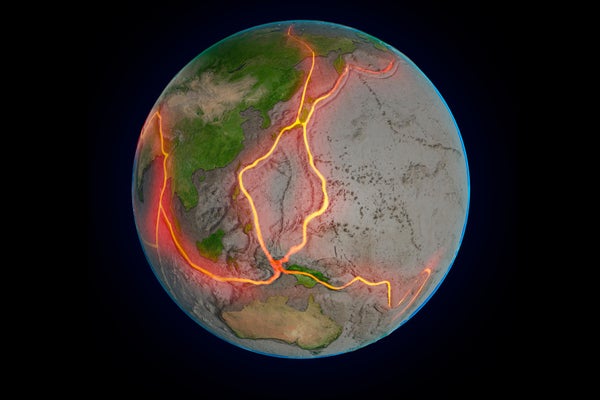www.scientificamerican.com
December 3, 20248 min readCould Plate Tectonics Crack Open Earths Deepest Mystery?Plate tectonics, or the recycling of Earth's crust, may have begun much earlier than previously thoughtand may be a big reason that our planet harbors lifeBy Stephanie Pappas & LiveSciencePlate tectonics may have played a larger role in the evolution of life on Earth than we previously thought. Andrzej Wojcicki/Science Photo Libary/Getty ImagesEarth's surface is a turbulent place. Mountains rise, continents merge and split, and earthquakes shake the ground. All of these processes result from plate tectonics, the movement of enormous chunks of Earth's crust.This movement may be why life exists here. Earth is the only known planet with plate tectonics and the only known planet with life. Most scientists think that's not a coincidence. By dragging huge chunks of crust into the mantle, Earth's middle layer, plate tectonics pulls carbon from the planet's surface and atmosphere, stabilizing the climate. It also pushes life-fostering minerals and molecules toward the surface. All of those factors add up to a place where life thrives from ocean abysses to towering peaks.But researchers don't know why or when plate tectonics started, making it hard to determine how essential this process was to the evolution and diversification of life. Some think plate movement fired up as little as 700 million years ago, when simple multicellular life already existed. Others believe only single-celled organisms reigned when Earth's plates first cracked apart.On supporting science journalismIf you're enjoying this article, consider supporting our award-winning journalism by subscribing. By purchasing a subscription you are helping to ensure the future of impactful stories about the discoveries and ideas shaping our world today.In fact, as new methods allow scientists to look ever-deeper into the past, some are now arguing that plate tectonics emerged very soon after Earth's formation perhaps predating life itself. If this hypothesis is true, it may suggest that even the most primitive life evolved on an active planet and that means plate tectonics could be an essential ingredient in the search for alien life."The only way we can reliably see a long-term history is on our own planet," said Jesse Reimink, a geoscientist who studies early Earth history at The Pennsylvania State University. "We really need to understand the life cycle of a planetary body before we can do a lot with the exoplanet data."Destruction of evidenceOnly Earth has jigsaw-like tectonic plates that crash together and pull apart like bumper cars. The other rocky planets in the solar system have a single, rigid shell of crust a geological arrangement that scientists call "stagnant lid" or "single lid" tectonics.In plate tectonics, pancake-like chunks of brittle crust and upper mantle ride on the hotter, more mobile mantle below. New crust forms at midocean ridges, where gaps between separating plates create space for magma from the mantle to rise. In a geologic balancing act, dense oceanic crust is destroyed at subduction zones, where one plate slides under another. The oldest known bit of oceanic crust, located in the Mediterranean, dates to just 340 million years ago, making it far too young to be useful for pinpointing when plate tectonics arose.Fissures along the ridge of two tectonic plates moving away from each other in Krafla, North-Eastern Iceland.Michele D'Amico supersky77/Getty ImagesContinental crust is lighter than oceanic crust and floats above the destruction wrought by subduction. But still, very little remains from Earth's early days, and what is left is eroded and warped. Fewer than 7% of rocks on the surface today are older than 2.5 billion years. Go back before 4.03 billion years, to the Hadean eon, and the rock record has completely vanished. The first half billion years of Earth's life left not a single bit of basalt behind.Because of this constant planetary recycling, the oldest incontrovertible evidence of plate tectonics rocks formed solely in subduction zones dates back only around 700 million years. Another strong bit of evidence, pieces of oceanic crust pushed up on continental crust during subduction initiation, emerged globally around 900 million years ago. In this geological time frame, multicellular animals, such as sea sponges and comb jellies, were just emerging.Some geoscientists think plate tectonics has been operating only since that time. But more suspect that plate tectonics emerged earlier, in the Archean eon, which ran from 4 billion to 2.5 billion years ago. The evidence is based largely on chemical analyses of rocks. For example, around 3 billion years ago, there are hints of an increasing amount of crust melted and reformed rather than forming directly from mantle rocks. Around 3.8 billion years ago, a shift in the chemistry of Earth's oldest minerals suggests a change from a stable, long-lived crust to a shorter-lived, more modern-looking crust, perhaps indicating the start of subduction. Though there is no single agreed-upon date, the Archean looks promising as a time when big geological changes were happening on Earth."It points to a really important transition," said Nadja Drabon, an Earth and planetary scientist at Harvard University who led the study indicating the switch to shorter-lived crust.A handful of sandWhenever tectonics began, geoscientists agree that it probably helped fuel the evolution and complexity of life."There could be billions of planets with some kind of primitive life, but the ability to build a radio transmitter or launch a rocket ship requires a certain set of circumstances which are only likely to happen on a planet that has plate tectonics and both oceans and continents," Robert Stern, a geoscientist at the University of Texas at Dallas, told Live Science.In prehistoric animals, plate tectonic activity has been tied to faster rates of evolution, probably because geological movements split up habitats and create new niches for life to evolve.The coelacanth's evolution was likely driven in part by plate tectonics, past research suggests.loonger/Getty ImagesPlate tectonics also may have enabled life to recover from devastating mass extinctions. For instance, at the end of the Permian period, a mass extinction driven by carbon-dioxide-spewing volcanic eruptions killed off 90% of species on Earth. Life on the planet ultimately recovered because weathering of continental rocks breaks down carbon-bearing minerals and washes them into the ocean, where marine organisms turn them into reefs and shells that become limestone and are eventually subducted back into the planet's interior. When the atmosphere goes haywire, tectonics gradually shifts Earth back into an environment that's more conducive to life.While nearly all geoscientists agree with the idea that, without plate tectonics, life on Earth might be limited to primitive organisms, a small group of researchers is now suggesting that plate tectonics could have emerged even earlier perhaps contributing to the origin of life itself by bringing minerals that support life from the planet's interior to the crust.This is tricky territory, pushing researchers back before 4 billion years ago, into the Hadean eon. The only direct evidence of the first 500 million years of Earth's existence is the presence of zircons, minerals that survive melting at mantle temperatures and pressures. Though the rocks once containing these minerals have melted away, the zircons which are smaller than grains of sand remain."They're teeny-tiny, and we just throw the kitchen sink at them trying to get every last little piece of information we can get from them," Drabon told Live Science.These zircons from the Hadean are sparse; all of them found worldwide could likely fit in a thimble. Yet this handful has shown that Earth had an ocean as early as 4.4 billion years ago just 200 million years after the planet formed and not long before the ancestor of all life today existed. By as early as 600 million years after Earth formed, according to a study published in June, the planet had both land and fresh water.To some researchers, this suggests Earth's crust may have been recycling in the Hadean. Water weakens the crust, creating the potential for breakage and thus subduction, said Jun Korenaga, a geophysicist at Yale University. Because water is necessary for plate tectonics, the question becomes, "Why can't we have plate tectonics if we had surface water?" Korenaga said.In experimental work published in 2023, researchers melted rocks at high pressures and found that conditions that mimic subduction create rocks similar to Earth's oldest rocks. Korenaga also argues that plate tectonics is the only effective way to reduce the amount of carbon dioxide in early Earth's atmosphere from the levels found on Venus to the more moderate concentrations that existed by the beginning of the Archean on Earth.Intriguingly, another important event happened during the Hadean that makes Earth undeniably different from its rocky neighbors: About 100 million years after Earth first coalesced, a planet-size body slammed into it, thoroughly shattering and melting both bodies and flinging off the material that would become the moon. A paper published earlier this year modeled this impact and found that the mixing of the two bodies could have created plumes of hot material in Earth's mantle that may have kicked off subduction around 200 million years later."Why is Earth the only rocky planet to have plate tectonics?" said Qian Yuan, lead author of that paper and a postdoctoral fellow in geodynamics at the California Institute of Technology. "I think the moon-forming giant impact could be the main factor."But not everyone is convinced by this story. A Hadean start to plate tectonics is an intriguing idea, T. Mark Harrison, a professor emeritus of geoscience at UCLA, told Live Science, but the evidence is still fairly minimal. He worries that geoscientists on all sides of the issue are overconfident in their claims. "But the last thing we need is a new form of groupthink based on, literally, a thimble-full of sand grains," Harrison wrote in an article with the appropriately blunt title "We don't know when plate tectonics began."Life on other worldsIf plate tectonics fuels life, or even just complex life, the search for other organisms among the stars may lead humanity to a geologically active planet.Unfortunately, we can't yet detect plate tectonics on far-off exoplanets, said Tobias Meier, an expert on mantle dynamics at the University of Oxford. But in 2021, Meier and his team used thermal data and computer modeling to determine that the rocky exoplanet LHS 3844 b, which sits 49 light-years from Earth, might have an active mantle and moving crust.Researchers suspect exoplanet LHS 3844b, located 49 light-years from Earth, may also have plate tectonics.NASA, ESA, CSA, Dani Player (STScI))LHS 3844 b isn't likely to host life. It orbits very close to its star and has no atmosphere. Half of the planet is in permanent daylight, with a temperature of 1412 degrees Fahrenheit (767 degrees Celsius), while the other is a frigid minus 429 F (minus 273 C) at night. It's this temperature difference between the two sides of the planet that drives mantle motion in LHS 3844 b, Meier and his colleagues reported in 2021. If real, that version of plate tectonics looks nothing like Earth's. But it shows the diversity of planetary geology that could lurk elsewhere in the cosmos."In the end, understanding what causes tectonics and whether it could operate on different planets will help us understand whether these planets will be habitable," Meier said.More powerful telescopes such as the James Webb Space Telescope may lead to better hints of exoplanet geology in the near future. But Earth's close neighbors deserve scrutiny, too, said Craig O'Neill, a geophysicist at Queensland University of Technology in Australia. Venus is right next door, and it's still controversial whether it had tectonics in the past. Understanding its current, single-lid geology could help scientists figure out why the two planets' fates diverged, and whether plate tectonics may explain why one planet hosts life and the other likely doesn't."A lot of the development of where we're going to go in plate tectonics is going to come from looking up," O'Neill told Live Science, "rather than navel-gazing in."Copyright 2024 LiveScience, a Future company. All rights reserved. This material may not be published, broadcast, rewritten or redistributed.











